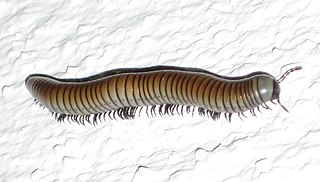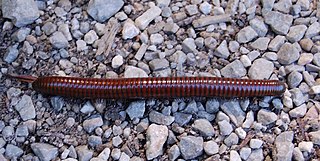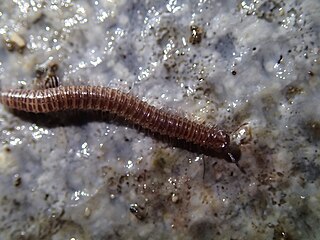
Carl August Graf Attems-Petzenstein was an Austrian myriapodologist and invertebrate zoologist. He published 138 scientific papers, most of them dealing with his specialist field, the myriapods. He described about 1800 new species and subspecies from all over the world.

Julidae is a family of millipedes in the order Julida, containing more than 600 species in around 20 genera. Its members are largely confined to the Western Palaearctic, with only a few species extending into the Oriental and Afrotropical realms. They are united by a characteristic form of the mouthparts, and are classified in the superfamily Juloidea of the order Julida, alongside the families Trichoblaniulidae, Rhopaloiulidae and Trichonemasomatidae.

Julida is an order of millipedes. Members are mostly small and cylindrical, typically ranging from 10–120 millimetres (0.39–4.72 in) in length. Eyes may be present or absent, and in mature males of many species, the first pair of legs is modified into hook-like structures. Additionally, both pairs of legs on the 7th body segment of males are modified into gonopods.

Ommatoiulus is a genus of millipedes in the family Julidae.

Pachyiulus is a genus of julid millipedes containing the following species:

Julus is a genus of millipedes in the family Julidae, containing the following species:

Chordeumatida is a large order of millipedes containing more than 1,400 species. Also known as sausage millipedes, they are found nearly worldwide. Chordeumatida is the largest order in the superorder Nematophora, a group also known as spinning millipedes because their telsons feature spinnerets used to build nests of silk. These millipedes produce this silk to create chambers in which to molt or to lay their eggs.

Trachysphaera is a genus of dwarf pill millipedes in the order Glomerida. Just over 30 species are known, making it the third most species-rich genus of Glomerida. Trachysphaera species are patchily distributed throughout Europe and western Asia, extending from Spain to Caucasia. Members of this genus are tiny, with modified appearances resembling that of calcareous stones.

Geophilus is a large, heterogeneous genus of soil centipedes in the family Geophilidae largely considered to be synonymous with Brachygeophilus. The generic name first appeared in Brewster's Edinburgh Encyclopaedia in 1814 as Geophilus electricus. This genus has a Holarctic distribution.

Anthroleucosomatidae is a family of millipedes in the order Chordeumatida. This family includes more than 100 species distributed among 40 genera. This family has a mostly Holarctic distribution, with the greatest diversity in the area around the Mediterranean sea.

Craspedosomatidae is a family of millipedes in the order Chordeumatida. Most adult millipedes in this family have 30 segments, but some have only 28. There are at least 30 genera and 210 described species in Craspedosomatidae.

Anamastigona is a genus of millipedes in the family Anthroleucosomatidae. There are about 20 described species in Anamastigona, found mainly in Europe and the Middle East.

Ophyiulus is a genus of millipedes in the family Julidae. There are more than 30 described species in Ophyiulus.
Dorypetalum is a genus of millipedes in the family Dorypetalidae. The seven species of Dorypetalum are found throughout the Balkan peninsula, the Carpathian mountains and Asia Minor.

Trichopolydesmidae is a family of millipedes belonging to the order Polydesmida. This family includes two genera notable for featuring sexual dimorphism in segment number: adult females in these genera have the 20 segments usually found in this order, but adult males have only 19. This family also includes the species Deharvengius bedosae, notable for being among the very few species in this order to feature adults with only 18 segments rather than the 20 segments usually found in polydesmids.
Buchneria is a genus of millipedes belonging to the family Julidae.
Devillea is a genus of flat-backed millipedes in the family Xystodesmidae. These millipedes are rare and limited to caves. Species in this genus are found in Sardinia, Capri, and southern France in the Maritime Alps. These species are notable for featuring more than the 20 segments usually found in the order Polydesmida. This genus is one of only two genera in this order to feature these extra segments and the first such genus to be discovered.
Haasea is a genus of millipedes in the family Haaseidae. This genus is the largest in this family, with 17 accepted species. Millipedes in this genus have either 28 or 30 segments.

Cyphobrachyiulus is a genus of millipedes in the family Julidae. It contains around 21 species. Members can be found in southwestern Russia, Turkey, Greece, and Bulgaria.
Graecoiulus is a genus of millipedes in the family Julidae. Members of the genus can be found in parts of the Balkans. The genus contains about 4 species.














